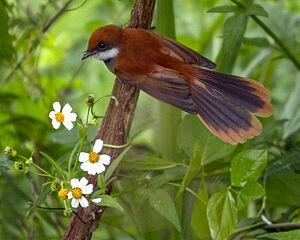Palau fantail facts for kids
Quick facts for kids Palau fantail |
|
|---|---|
 |
|
| Conservation status | |
| Scientific classification | |
| Genus: |
Rhipidura
|
| Species: |
lepida
|
The Palau fantail (Rhipidura lepida) is a small, charming bird found only in the country of Palau. It's part of the fantail family, known for their fan-shaped tails.
Contents
About the Palau Fantail
Scientists group living things based on how they are related. The Palau fantail is part of a group of birds called 'fantails'. It's closely related to other fantails found in Indonesia, like the long-tailed fantail and the Sulawesi fantail.
Its scientific name, Rhipidura lepida, was given by two scientists, Hartlaub and Finsch, in 1868. The word lepida comes from Latin and means 'charming'.
What Does It Look Like?
The Palau fantail is a typical fantail bird. It has a short body and a long tail. This bird is about 18 centimeters (7 inches) long.
Colors and Markings
- Its head, back, and upper tail are a cinnamon color.
- The throat and cheeks are white.
- It has a black chest.
- Its wings are black with cinnamon edges.
- The belly is white.
- The tail is black with rufous (reddish-brown) tips.
Both male and female Palau fantails look the same in color. However, females are usually a little smaller. Young fantails have brown upper parts and dull white throats.
Where Does It Live?
The Palau fantail lives only in Palau, a country in the Pacific Ocean. This means it is an endemic species. You can find it on several islands there, including Babeldaob (the largest island), Koror, Urukthapel, Eil Malk, and Peleliu.
Its Home Environment
These birds prefer to live in forests. This includes old, untouched forests, newer forests that have grown back, and small patches of forest found in ravines within grassy areas. Sometimes, they might go into scrubland or even mangrove forests, though this is less common. The Palau fantail does not migrate; it stays in Palau all year round.
How It Behaves
The Palau fantail is a very active bird when it's looking for food. It hops and flies around, searching for insects. It can catch prey right out of the air or pick it off plants.
Feeding Habits
This bird moves through the lower and middle parts of the forest, called the subcanopy and undergrowth. It sometimes even takes insects from tree trunks and rocks.
Nesting and Reproduction
Scientists don't know much about how the Palau fantail raises its young. Its nest is a strong, cup-shaped nest. It is usually built in a fork of a tree branch and has a long, trailing tail of material hanging down.
Status and Conservation
The Palau fantail is not considered to be in danger of extinction. It only lives in Palau, but it is quite common there. In fact, its numbers are thought to have grown since the 1930s and 1940s. It is one of the most common forest birds in Palau. The IUCN (International Union for Conservation of Nature) lists it as a species of least concern. This means it is not currently facing major threats.


